Abilities
Criollo’s abilities were developed and improved in its homelands, particularly in Argentina, Brazil, Uruguay and Paraguay, which share the common culture of “Pampa”, over which reigns the gaucho or “paisano” and its horse the “Criollo”.Chile also historically breed horses called "Chilean Horse", very similar to the Criollo from the Pampa, but with some morphological and funccional differences due to the fields where they were bred and the works they were bred for, i.e. in smaller and many times mountainous areas because of the geographical situation of Chile. The Chilean horse is currently used to improve even more the docility and agility of the Criollo from the Pampa.
In its countries of origin, the Criollo is mostly used as a working horse. The gaucho in Argentina, Uruguay and Southern Brazil, uses the Criollo to achieve all the daily tasks required by a geographically extended “ estancia” (ranch in South America), and most particularly transportation, cattle care and sorting.
The Criollo was selected and is now well known for its cow sense, its great handling and recovery abilities and resistance. Indeed, it is able to work all day long and walk considerable distances with cattle, like over hundreds or thousands of acres. It is also popular for its incredible hardiness that allows him to work hard and be in good shape eating the grass of the pampa...
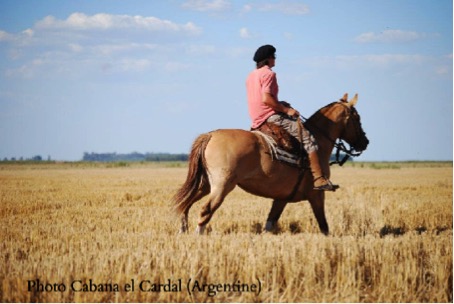
The selection of Criollos in their home countries
There are regional and national competitions organized to select the criollos for their morphology and functional abilities.Among the most famous "Expositions": the Expo PRADO in Montevideo (uruguay), the Expo Otoño organised during the big event "Nuestros Caballos" with the national Freno de Oro competition in Buenos Aires by the end of March, the “Otoño Exhibition” in Uruguay by the end of April, the Ayacucho Exposition taking lace in Argentina in february, the Tandil Exposition in November (Argentina), the Expointer Exhibition in Esteio in Brazil by the end of August, and the spectacular Rural Exhibition of Palermo that takes place by the end of July in the neighbourhood of Buenos Aires (http://www.exposicionrural.com.ar) where the most beautiful Criollo Horses are competing.
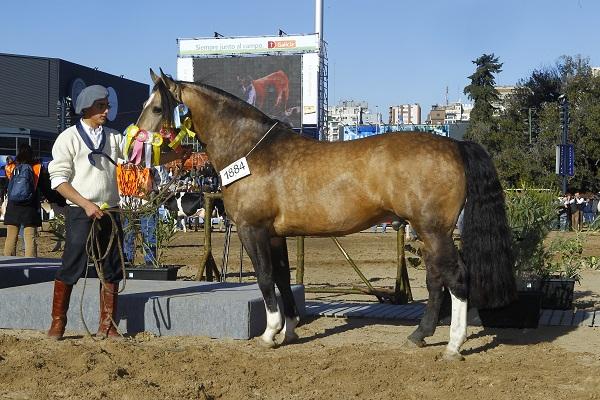
Photo : Exposition de Palermo 2012- Charque Leopardo- Grand Champion catégorie mâles et étalon adulte.
Every three years, the International Federation of Criollo Horse Breeders (“FICCC”) organizes a big international Show called FICCC EXPO, where the best Criollos and riders from Argentina, Brazil, Uruguay y Paraguay come to compete in morphological competitions, long distance races (“Marcha”), rodeo and Freno de oro competitions. The last Expo FICCC event took place in March 2015 in the city of Buenos Aires. You can have a look on the website of the EXPO 2015 at this page: www.caballoscriollos.com/ficcc_2015
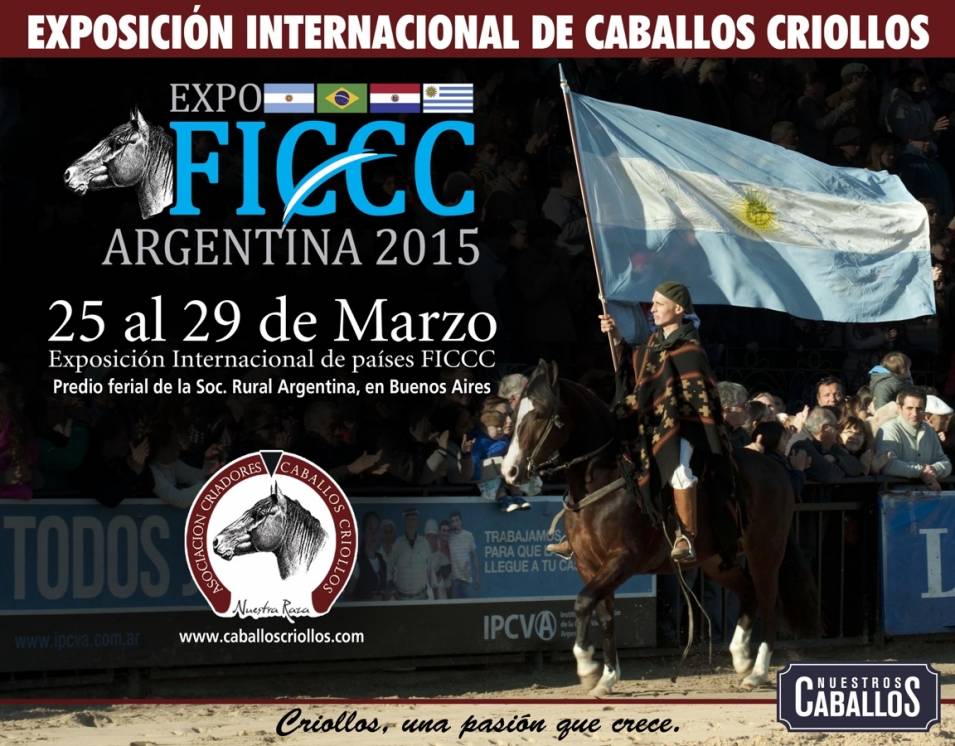
How about Chile and the FICCC? In this regard, it is interesting to notice that the Chilean Horse, if many people consider this horse as a “Criollo”, is not considered as “Criollos” anymore by the Chilean themselves since a few years. In 2011, the members of the Chilian Horse Breeders Federation (“FCCC”) voted a resolution and decided not to designate their national horse as a “Criollo” anymore but to call them « Caballo chileno » (or “Chilean Horse”), and as a consequence ordered the closing of the studbook of the new Chilean Horse. Basically, Chilean breeders consider that their national horse is different from the rest of the Criollos, due to a different history, different selection and horse culture different from the “pampa’s culture”.
The resolution adopted in 2011 by the members of the FCCC had also consequences on the participation of Chile to the FICCC. Chile is still a member of the FICCC, however its activity into the International Federation is now suspended since 2011 and Chile does not participate anymore to exhibitions organized by the FICCC.
Long distance races
The "Marcha de Resistencia de caballos criollos" are races organised to select Criollos in Brazil, Argentina and Uruguay. These very non typical races were created in 1946 with the organisation of the first “resistance raid for Criollo mares”. Since then, this type of races became more and more popular and became a major event to select Criollos, and for testing and preserve their recovery and resistance capacities. During these events, competitors cover 750 km ( 466 miles) in 15 stages over 15 days (an average of 50/60 KM per day – or 31/37 miles per day). To ensure the complete equality between competitors, the participating criollo horses are gathered all together 20 days before the starting day of the race at the event hosting location. During this 20 days, they won’t’ be ridden nor trained. The minimum weight carried by each horse during the race must be over 90 kg (198,4 lb), and the only authorized food is the grass available in the pasture during their rest periods (Source: Rules of the “Marcha de Resistencia” of the International Federation of Criollo Horses Breeders-FICCC). These races aim at reproducing the traditional working conditions that Criollos have to face with in the everyday work of the South American ranches.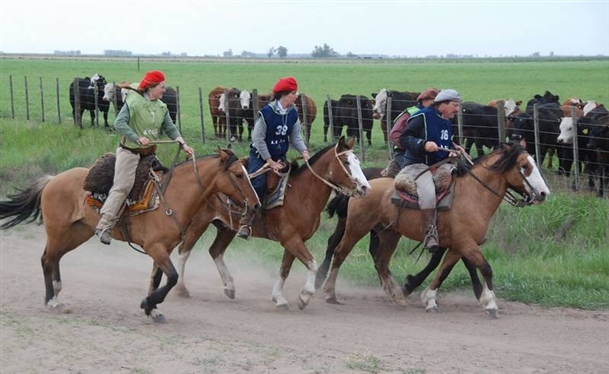
http://www.noticiaspehuajo.com/inf-general/culmino-la-marcha-de-caballos-criollos_a8962
Photo de la 67ème édition 2014 de la Marcha de Resistencia de los caballos criollos.
The "Freno de oro" or "Gold Bite" :
(Source: some information provided hereunder come from the book: “Criollos de América”, Ponce de Léon y Zorilla)One of the most spectacular competitions is probably the Freno de Oro where competitors are judged at the end of a morphology competition and the following 5 functional events where agility and cow sens are tested:
La prueba de los “Andares” where judges valuate the ease and fluency of the horse moves. The horse walks, trots and quarter doing circles in one hand and in the other hand.
La prueba de la “Figura” that is an exercise where the horse is quartering and slaloming between bundles of straw with changes of direction. Judges will valuate the speed, cadence, regularity of the quarter and fluidity in the change of foot.
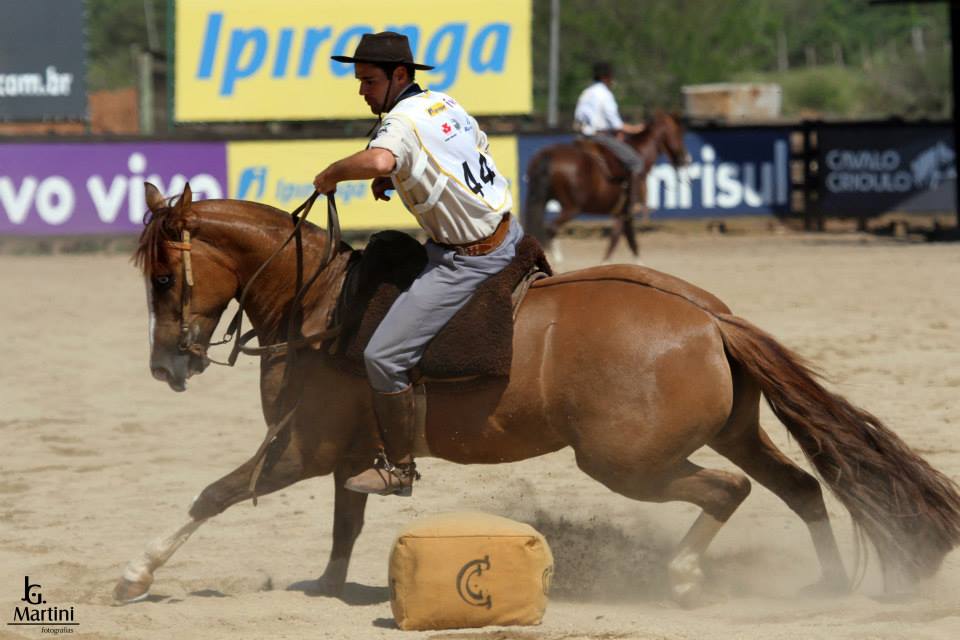
Photo : Escultura Gravata- Freio de Ouro 2014- Brésil, Photo JG Martini.
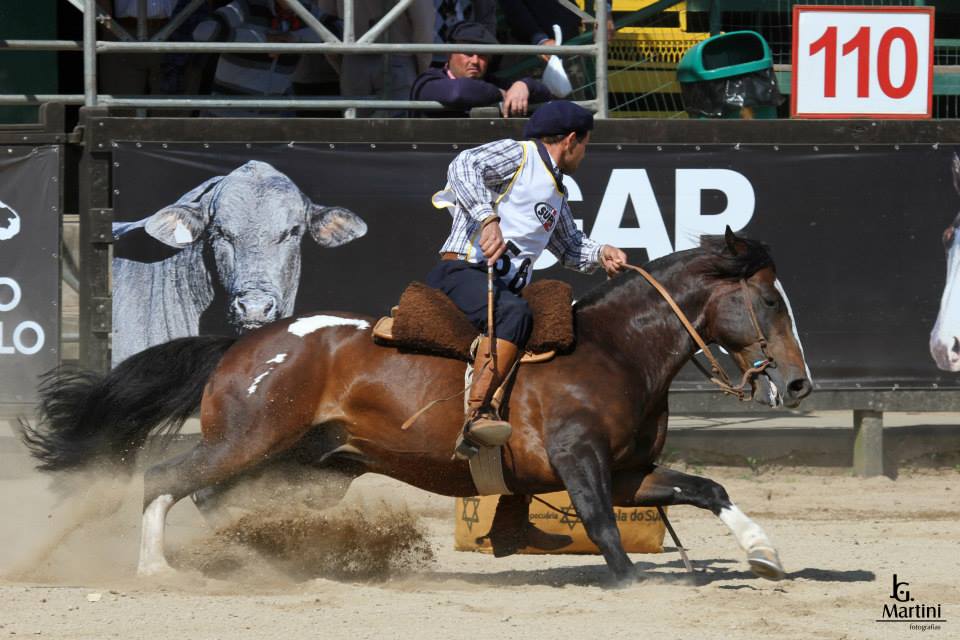 Photo : Vinho Tinto dos Castanheiros- Freio de Ouro 2014- Brésil, Photo JG Martini.
Photo : Vinho Tinto dos Castanheiros- Freio de Ouro 2014- Brésil, Photo JG Martini.La prueba de “Vuelta sobre las patas y Rayada” or “ spin and sliding stop” where the Criollo has to make from one to three turns on its back legs (similar to the spin in western riding) and then two sliding stops ending with back steps.
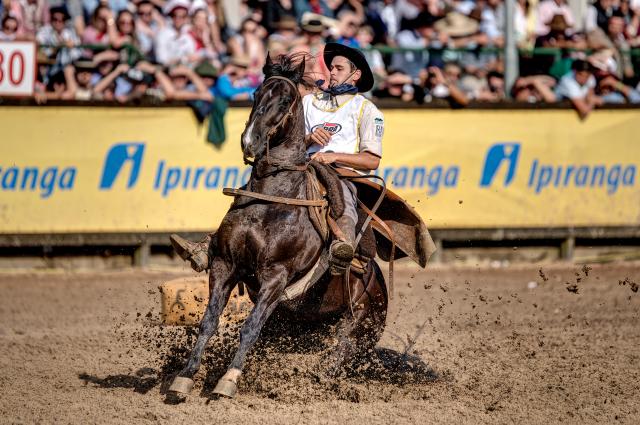
Photo : Epreuve n°3 de « Vuelta sobre las patas y Rayada »- Freno de Oro 2014 (Brésil)- Catégorie « Mâle ».
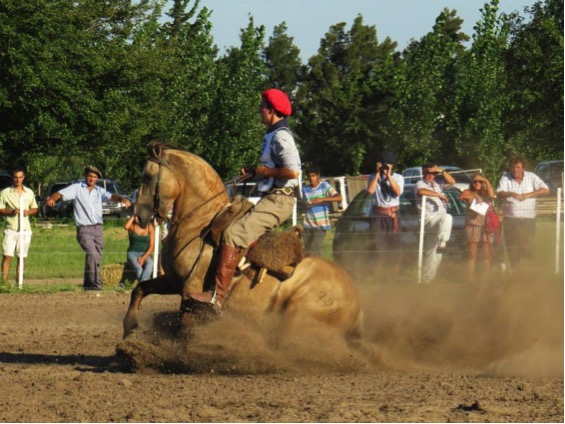
Photo : Epreuve n°3 de « Vuelta sobre las patas y Rayada »- « Tranqueador Mariscal monté par Horacio Casin de l’élevage Don Florencio- Freno de oro Argentina 2015- 3ème place catégorie mâles.
La prueba de la “Manguera” is very similar to the traditional Argentinian event called “corral de aparte”, and takes place in a small corral with a circular ridge built at the lower part of the fence. During this event, the horse has to deal with two calves?, cut one calf and maintain it separated from the other calf, before “pechar” it in one hand and in the other hand in order to stop its run and make him run in the other direction. “Pechar” means that to stop the calf’s run, the horse will push the calf with its chest against the fence with the help of the circular ridge. This event is used to valuate the horse agility, its power, bravery and cow sense.
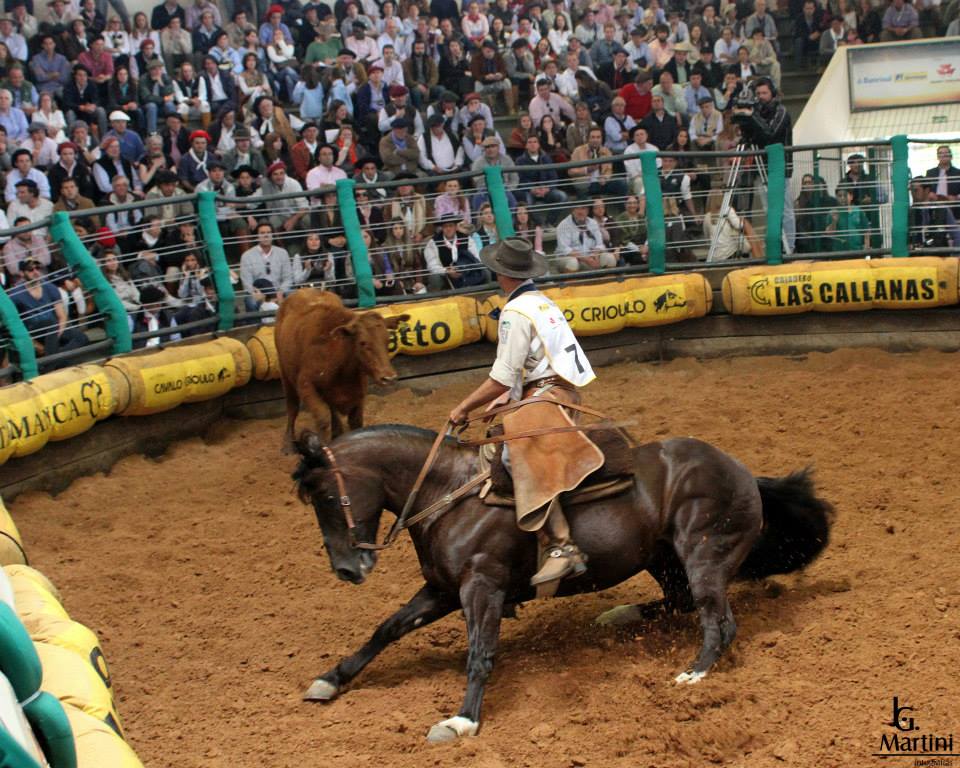
Photo : Destaque Da Maior, Freio de Ouro 2014- Brésil, Photo de JG Martini.
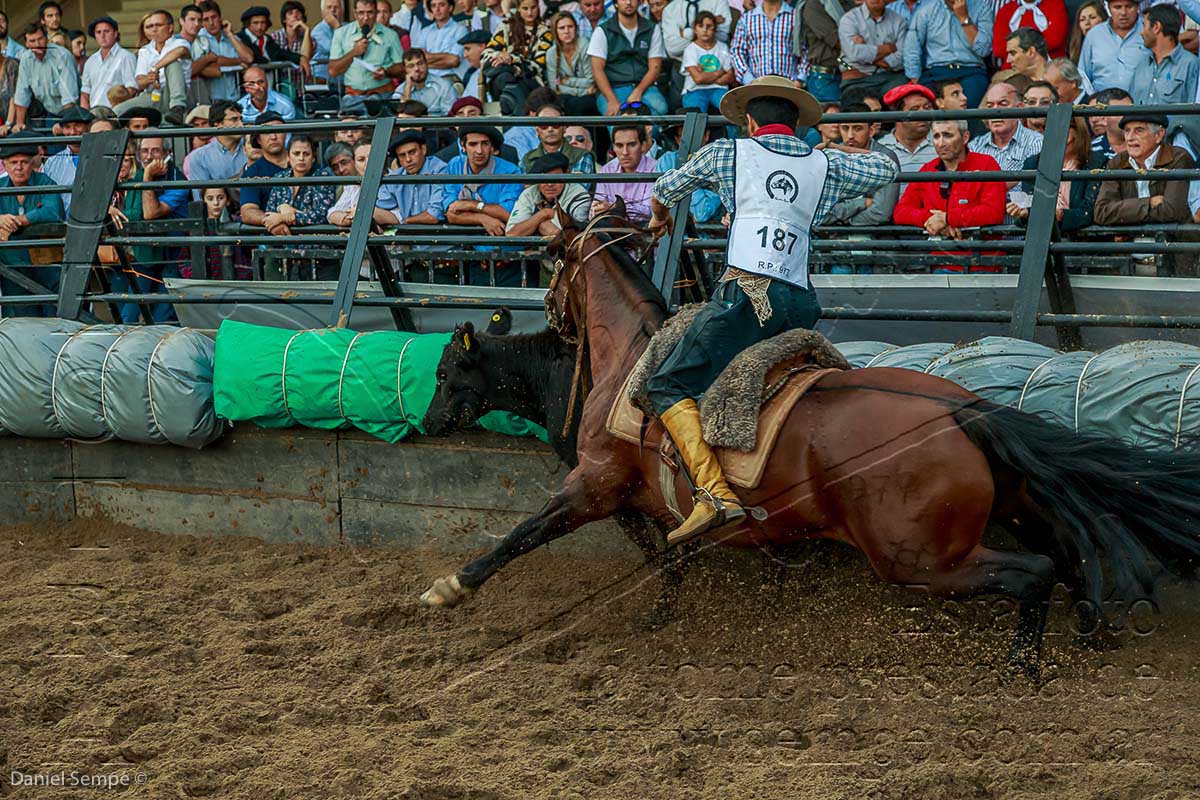
Photo : Daniel Sempe, Freno de Oro Argentina 2015
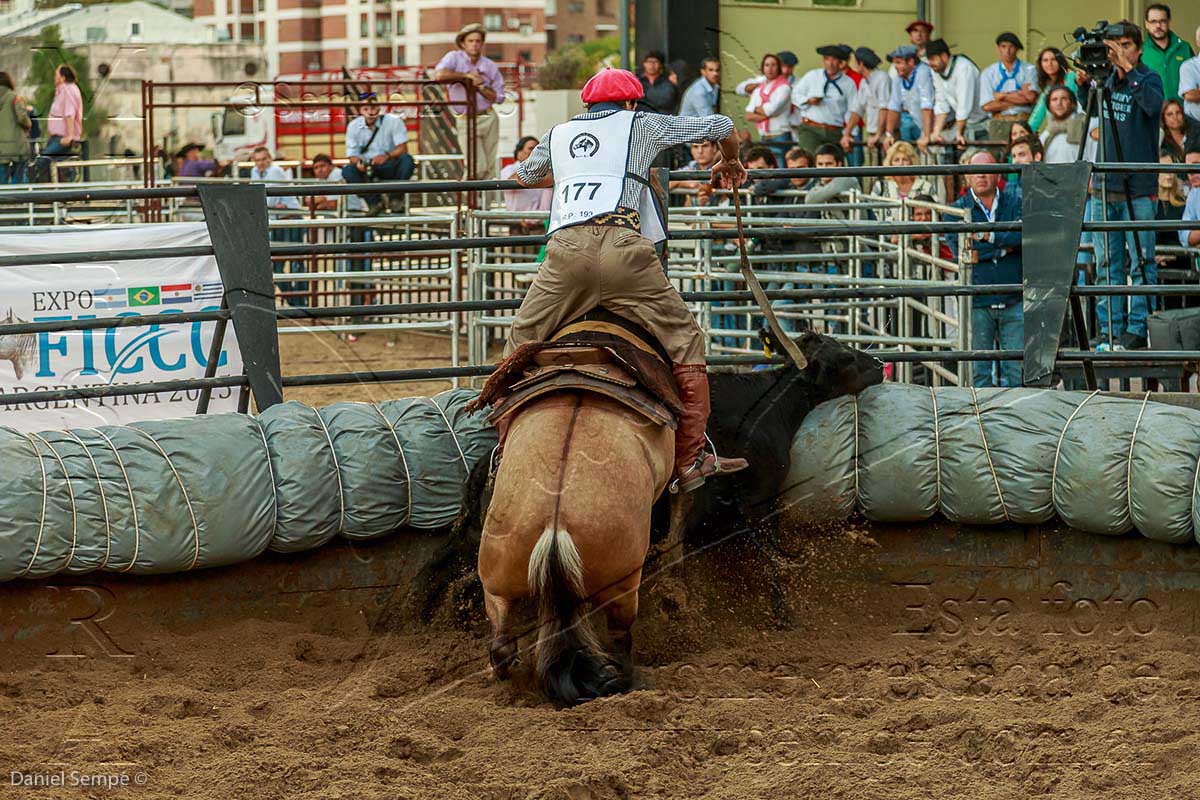
Photo : Daniel Sempe, Freno de Oro Argentina 2015
La prueba de campo, traditionally well known in Argentina as “Paleteada”, takes place in a corral that is around 120 metros long (395 ft long) where a team of two riders, , has to channel and guide (“paletear”) a calf quartering, then pass by the calf and stop its run. Each team will run twice, so each rider can run on a side of the calf and then on the other side.
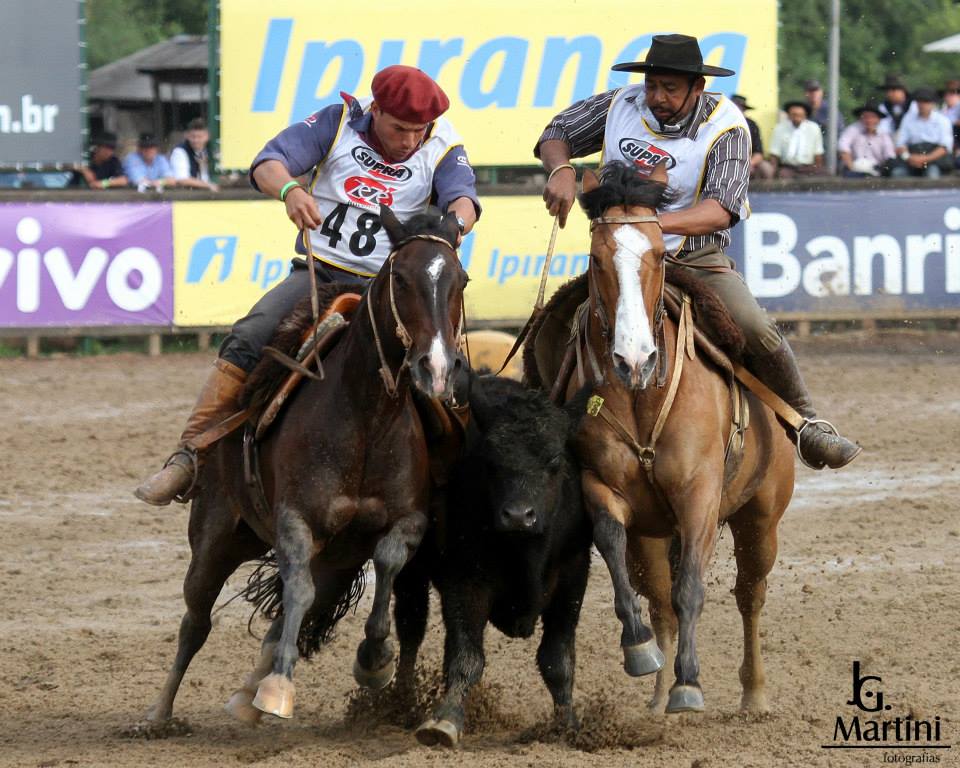
Photo : Sananduva do Salton et Capanegra Oña Guinda- Freio de Ouro 2014- Brésil, Photo de JG Martini
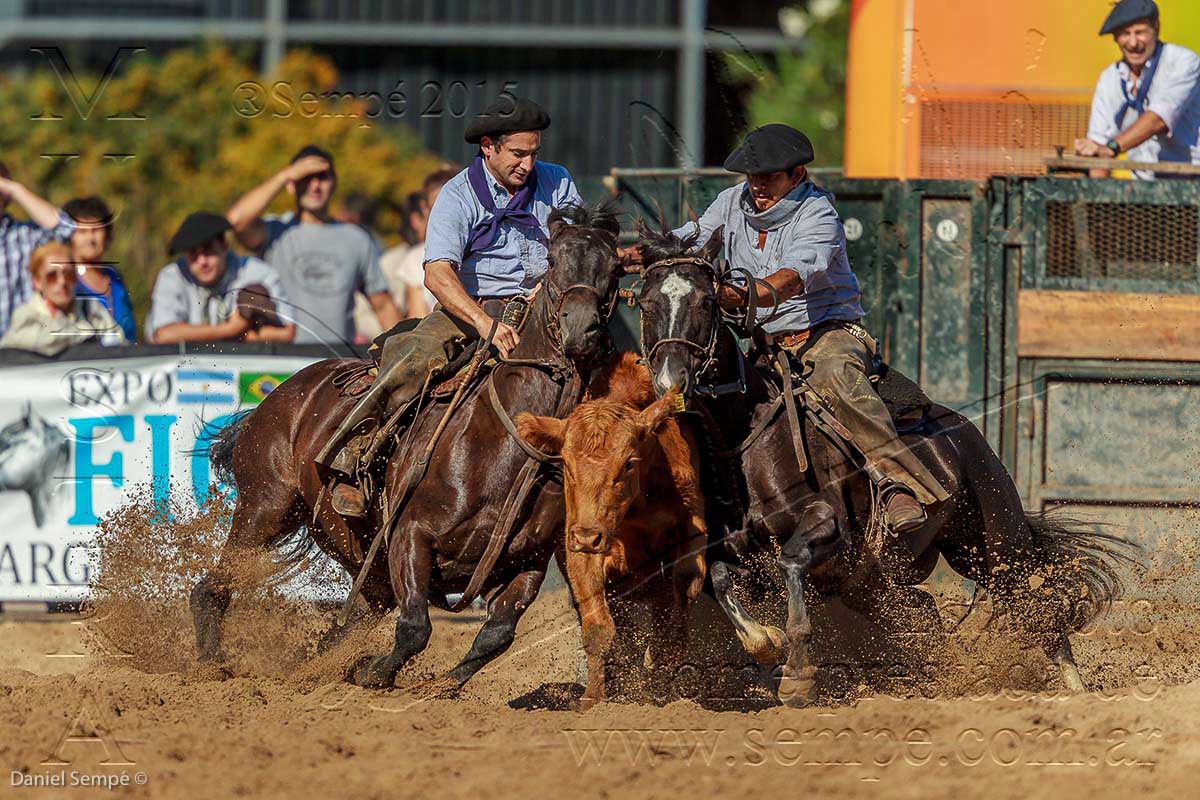
Photo: Daniel Sempe, Freno de Oro Argentina 2015 www.sempe.com.ar
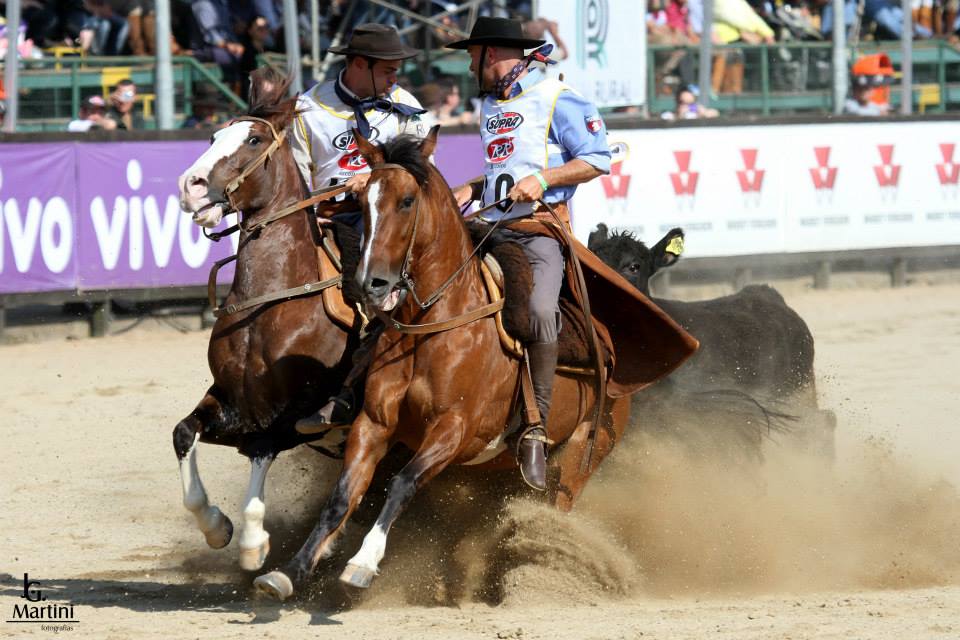
Photo : Ferrari Gravatá et ZR Brisa- Freio de Ouro 2014- Brésil, Photo de JG Martini https://www.facebook.com/jgmartinifotografias
The Criollo and the Reining in its Home Countries
It is also interesting to note that more and more Criollos are selected to participate in reining competitions, in particular in Brazil and Chile. At the World Equestrian Games of 2014 in Normandy, Chile participated for the first time of the History of the Games at the reining championship with two Chilean Horses c (Quimpomay Torero and Santa Isabel Bastral). One Criollo was also part of the Brazilian team.
Photo : Quelen Gitano, étalon criollo de l’élevage La Quebrada (Uruguay)
Before this date, in the 2010 Alltech FEI World Equestrian Games (« WEG »), Wellington Jesus Teixeira (Brazil) finished 14th in the individual reining competition on his grey Criollo gelding, SJ Rodopio. João Antonio Salgado Filho also represented Brazil in reining at the WEG on a Criollo horse, Leopardo Do Infinito, a bay roan stallion.
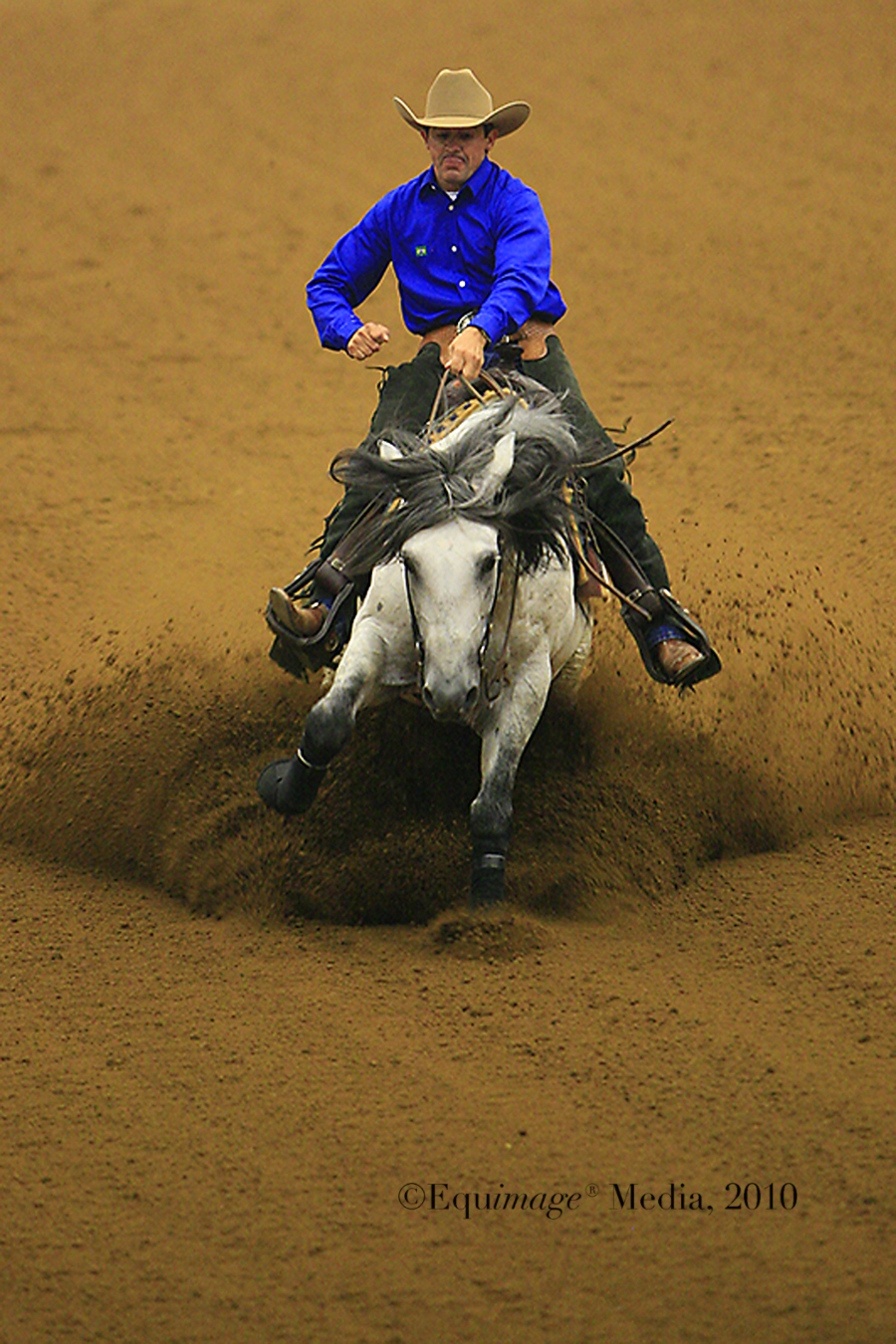
Photo: Wellington Jesus Teixeira et son criollo hongre SJ Rodopio, Brésil, Jeux équestres mondiaux 2010- reining.
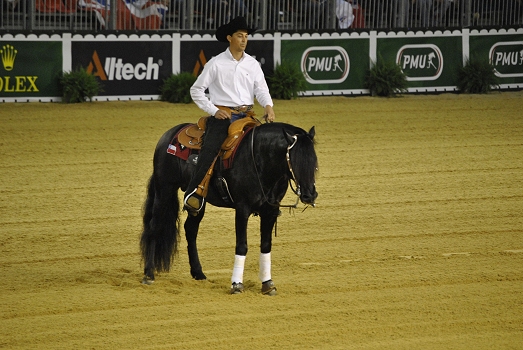
Photo : Daniel Cruz et l’étalon Cheval Chilien Quimpomay Torero, Equipe du Chili,
Jeux équestres mondiaux 2014-Reining.
Jeux équestres mondiaux 2014-Reining.
Some Reining Criollo bloodlines are seeing the light....
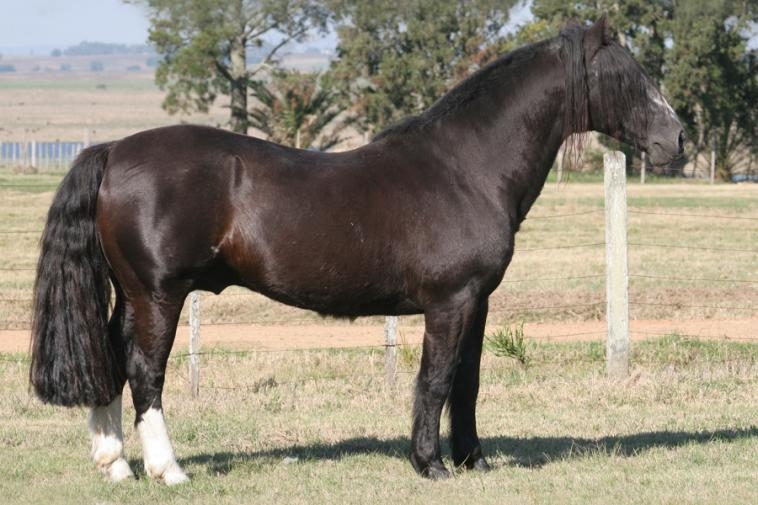
Foto: SANTA ELBA SEÑUELO –Head of breed in Brazil, remarkable reporductor, with sons and grand-sons winners of the Freno de Oro in Brazil. Among Finalists of the Freno de Oro competitions, 40% of the competitors have Señuelo's blood. It is at the fourth rank of the Criollo Register of Merit in Brazil, and let in this country 1.048 sons. Señuelo was borne in Chile on 30-8-1977. Among its descendants, many of them have excelent results in reining competitions.
And in Europe, what can we do with Criollos?
A horse for hiking and travels
You are an outdoor rider, you enjoy hiking, horseback travels, wide-open spaces: as you probably already understood, the Criollo is made for you and will be your ideal and best companion.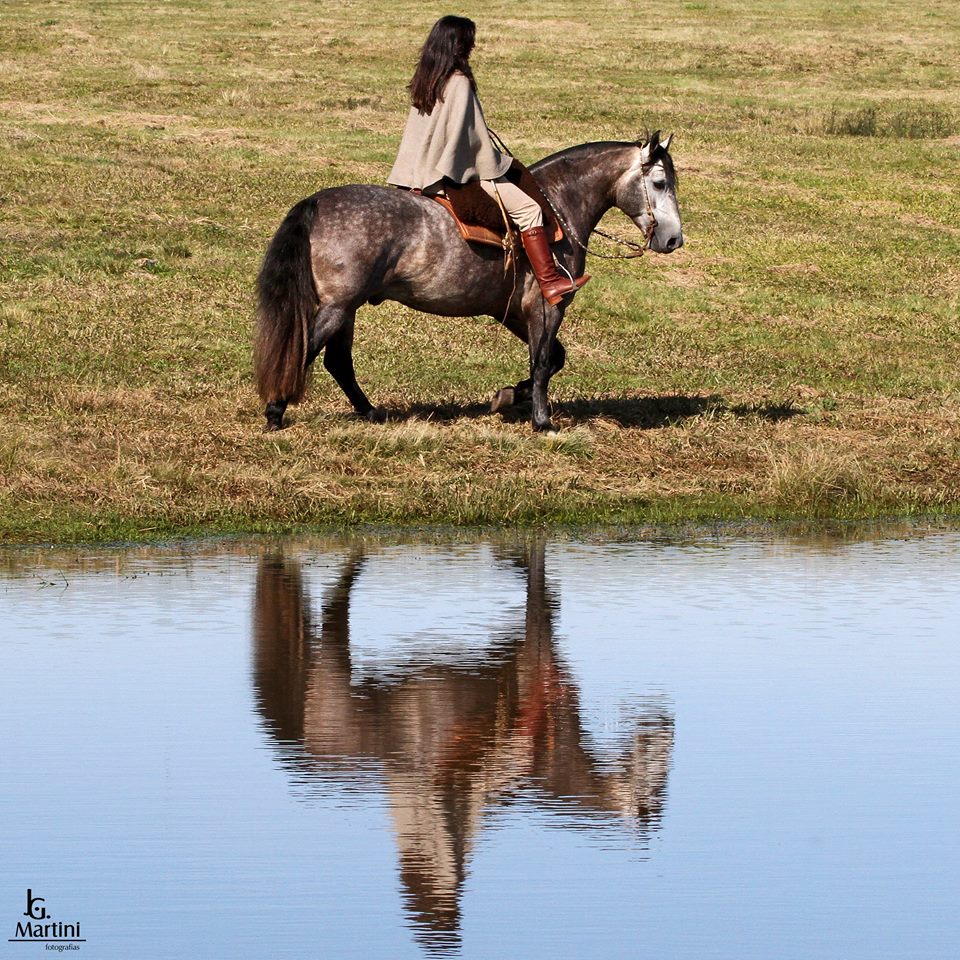
Estradeiro Cavalera no Marcas de Raça 2014 - Photo JG Martini
This is a horse with a very “safe foot”, a horse you can trust that will take you with curiosity and without hesitation to all roads and fields you may wish to explore. Like many horses selected for outdoor life and work, it has a stable and cold mind in any circumstances, appreciable in the most incongruous situations ... If you like to compete, disciplines such like TREC are predestined to him.
It is also a particularly resistant horse and, as a consequence, a perfect travel companion. It has unusual recovery regularly tested during endurance races like in the famous Marcha de Resistencia. The longest travelling distances were covered with criollos. The first listed feat was accomplished by Gato and Mancha who crossed with their rider Aime F. Tschiffely the American continent, from Buenos Aires to New York in 3 years and 4 months. They covered 21,500 kilometres (15 534 miles) across plains, deserts, rainforests and mountains, with an average daily distance of 46.2 KM (28,7 miles).
This long trip that began in 1925 when Gato y Mancha were respectively 16 and 15 years old, highlighted not only the incredible strength of the criollo, but also its great adaptability. During this extreme trip, Mancha and Gato faced the scorching desert heat, the humidity and diseases of the jungle and crossed several times the Andes at an altitude of 5500 m (18045 ft) and by minus18 degrees (-0,4 Fahrenheit).
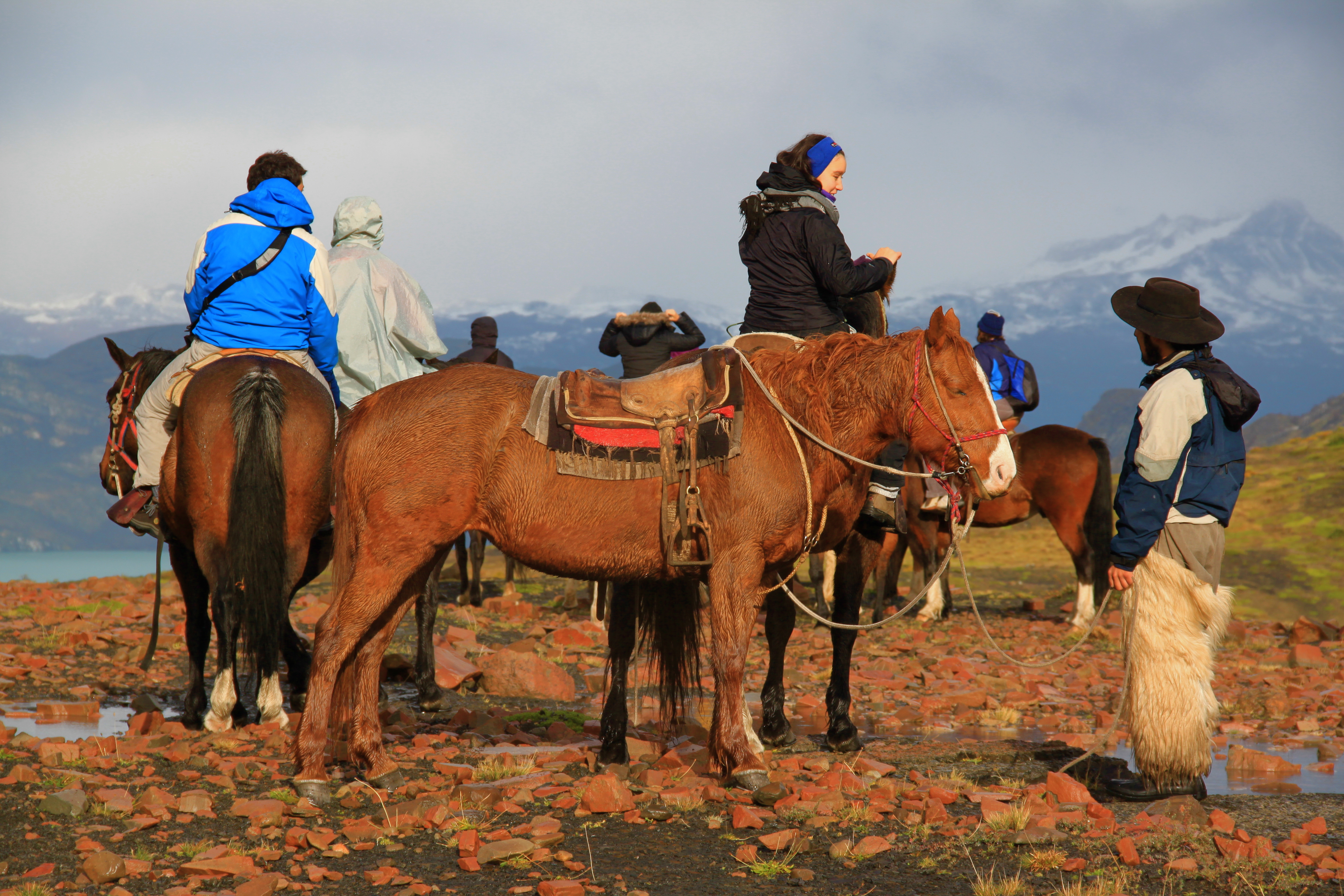
Copyright : Patagonie- ADFC- www.criollo-horse.com
A horse for western riding
The Criollo horse has the morphology of a working horse. It has a sloping and muscular croup with short and wide kidney that allows the engagement of the hind legs for very quick starts and good propulsion, essential to work with cattle. The shoulders are wide and oblique giving it very economical gaits in order to held the “jog” (very slow trot at the breaking point with the pitch) or slow canter for long distances without getting tired. Like many breeds of working horses the chest is broad and deep, legs are strong and short, which provides it a low center of gravity.These morphological characteristics predispose the Criollo for western riding. Agile, powerful, with a great cow sense, it is able to practice any kind of western riding discipline: Team penning, cattle penning, trail, ranch trail, reining, working cow.... it is up to you!

Loco de bueno Mapucho- Padrillo Criollo en Italia -finalista open derby reining oklahoma 2013
In Germany, the country with most Criollos breeders in Europe, Criollos already had excellent results in national and international competitions, especially in reining and working cow horse. The stallion Tape Isidoro from la Cabana La Esperanza of Marion Meyer participated in competition of European level and got more than 70 victories and rankings in various western disciplines, including reining.
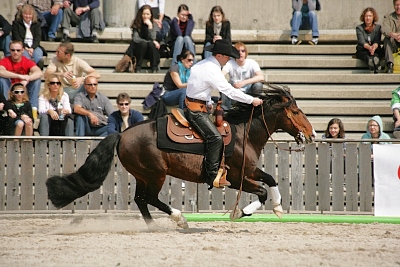
Photo : Tape Isidoro, étalon criollo de l’élevage la Esperanza (Allemagne)-
http://criollosdeutschland.wordpress.com
http://criollosdeutschland.wordpress.com
Other young stallions are currently having very good results in reining and working cow competitions. The most talented Criollo stallion in Europe is currently De Baviera Cimarron, born in Criollos de Baviera, owned by the breed CP-Criollos and trained by Joschka Werdermann. Cimarron de Baviera won in 2014 the "Junior Working Cowhorse EWU German Open 2014" and in 2015 le "Junior Ranch Riding German Championship" avec un score de 225,5.
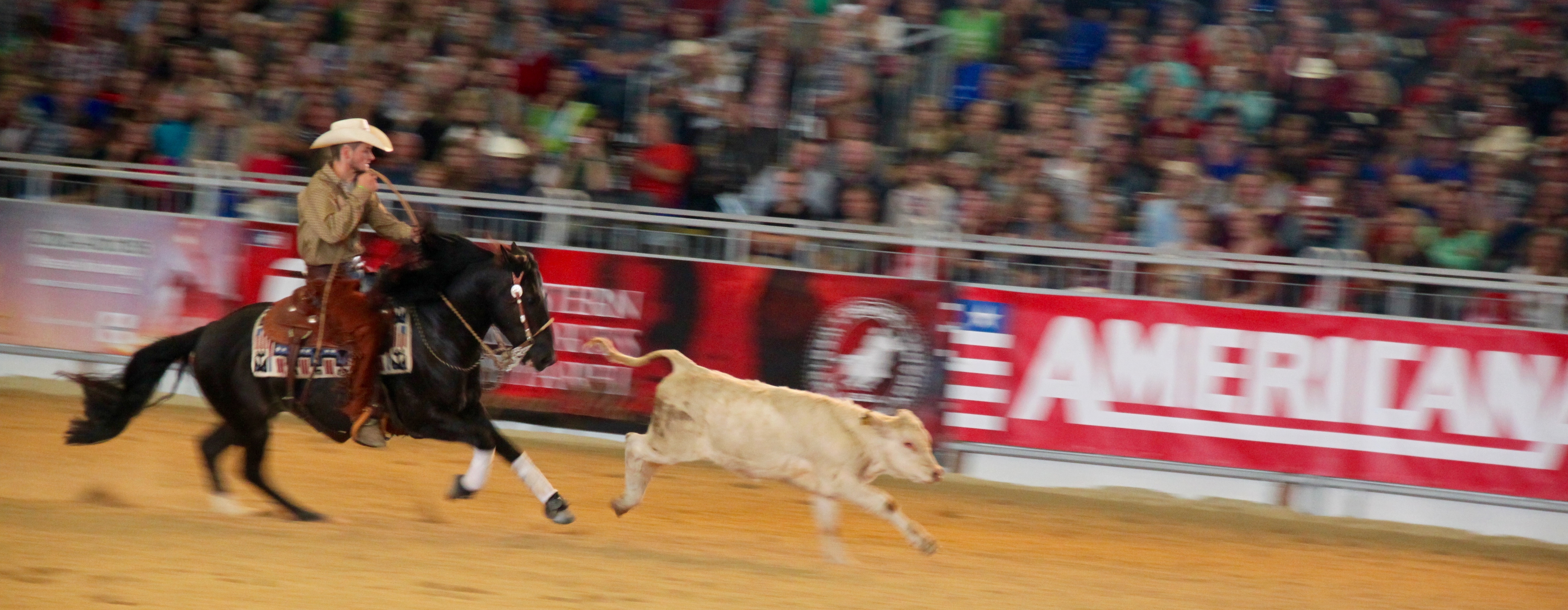
Photo: Cimarron de Baviera- Working Cow Horse Americana 2015

Photo: De Baviera Cimarron, étalon criollo de l’élevage CP-Criollos (Allemagne)- www.cp-criollos.de
At the Equita'Lyon 2012, the mare Chaca Julia and its rider Joschka Wedermann won the title of "Reserve Champion" category non-professional of the "Reined Cow horse Futurity". Julia Chaca is not a purebred Criolla, she is registered in Germany in the studbook of the “Cruzado” horse, her mother being, unlike its father, a criolla mare without pedigree.

Photo : Chaca Julia, jument « Cruzado » d’origine criolla de l’élevage CP-Criollos (Allemagne) - www.cp-criollos.de
Paddock polo
Argentinians are the best Polo players in the world. The Criollo horse made this reputation possible at some point. The Argentinian Polo Horse, now a full breed in Argentina with its studbook and own breeding stock, is the result of a mix between the Criollo horse and the English Thoroughbred Horse. The Criollo gave to this horse its agility, power and recovery, and the English Thoroughbred Horse its speed and a more slender body to be able to run in record time the polo grounds.If the purebred criollo is not used for Polo, it practices paddock polo, a polo discipline played in smaller grounds.
The Haras d'Andas, in France, obtained excellent results in paddock polo. In October 15, 2006, at the Open Polo French National Championship in Chantilly, a team from the Capitol Polo Club, attended by Joél Mingam and its criolla mare from the Haras d’Andas named Natilla, became Champion of France in Paddock Polo, category Open.
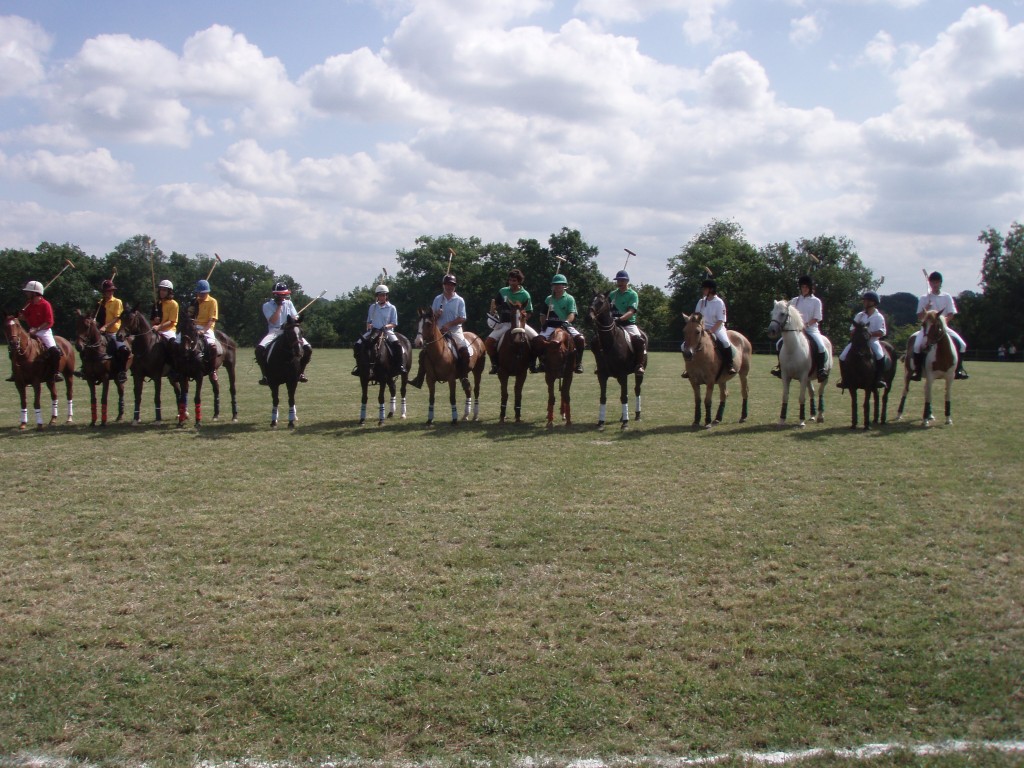
Photo : Haras d’Andas- www.criollos-france.com
A Versatile horse
Criollos can practice many other disciplines. If you have interest in jumping and dressage, it can be a good partner to start competitions, as long as you don’t ask it to jump 4,5 ft nor having the extended trot of a KWPN. In other words, if you like to "try everything", it will give you full satisfaction.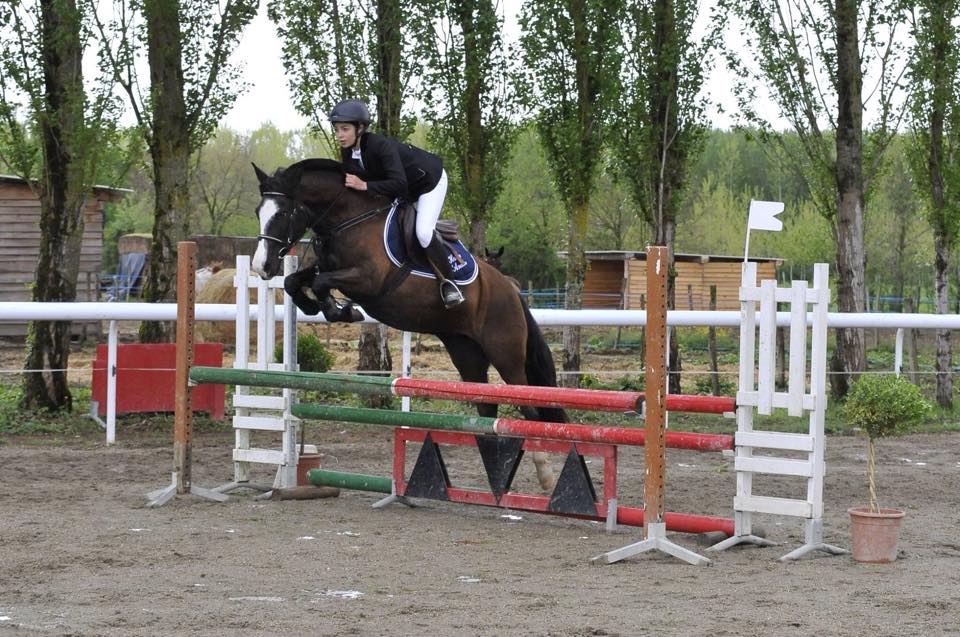
Photo: Criollos from the Haras d'Andas (France)
Because of its exceptional recovery, the criollo is able to participate and compete at the best level against Arabian horses in endurance races. If the purebred Arabian remains a master of this discipline, the criollo also has something to say when travelling miles with few recovery times. In Argentina and Uruguay, bloodlines of criollos are selected using endurance tests in order to enhance the recovery capacity of the criollo, as evidenced by the famous race called "Marcha de Resistencia de los caballos criollos". Endurance races of 30, 40, 60 and 80 km are regularly organized too. Patron Chico Engarrotao, a Criollo stallion owned by Aurore Descombes (France), was qualified in 60 and 90 km races.
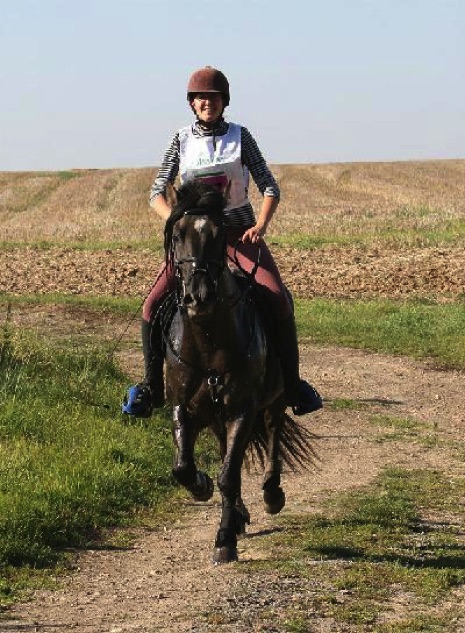
Photo : Patron Chico Engarrotao et Manon Moutillier.
Patron Chico ENgarrotao is now working in western riding!
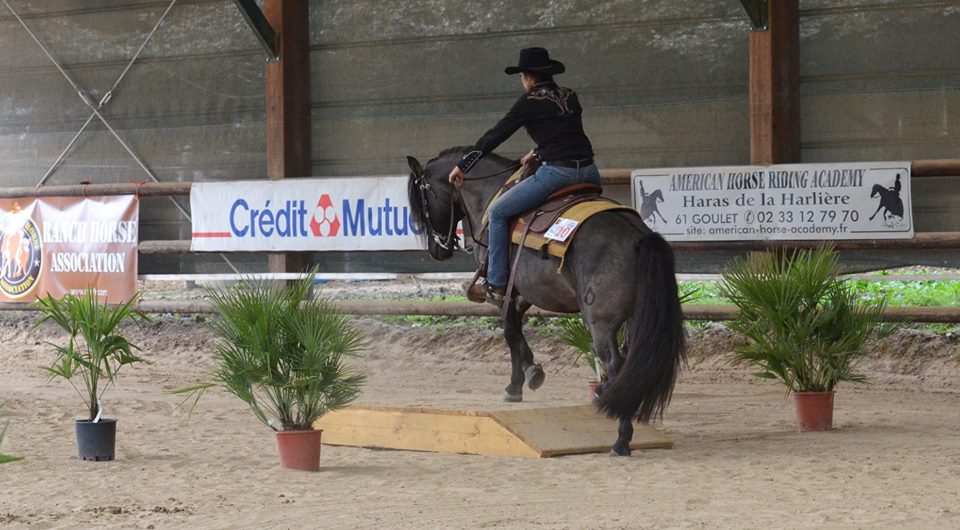 Patron Chico Engarrotao- Padrillo Criollo (Francia)- Trail Ranch VRH 2014
Patron Chico Engarrotao- Padrillo Criollo (Francia)- Trail Ranch VRH 2014
